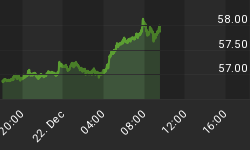Nouriel Roubini warns that an asset bubble is building as money chases commodities. Asian countries are considering capital controls to stem the inflow of hot money. The Wall Street Journal reports that rare coins are soaring at auctions, with a single penny recently breaking the $1 million barrier. U.S. stocks and crude oil are up 60% and 105%, respectively, from their post-crash lows. And of course gold is at a record high.
Looks like the stimulus orgy worked: Speculators are back and scooping up pretty much everything in sight.
Yet long-term bonds are just sitting there, which isn't what you'd expect at the beginning of another inflationary boom. Because bonds trade on inflationary expectations their yields should be rising and their prices falling. Why aren't they?
One possible explanation is that the bond market doesn't believe the new commodity bubble is for real, and expects a double-dip recession to send long-term rates even lower. That's not unreasonable, given the bad recent U.S. housing news and the widely-anticipated commercial real estate bloodbath. So next year stocks tank, the economy contracts, and bonds are the place to be. Here's blogger Mike Shedlock's take on the coming deflation.
Another possibility is that some of the newly-created currency that's not chasing commodities is being used to buy bonds. The following chart from Housing Doom shows that central banks have recently stepped up their purchases of U.S. Treasuries, while the Fed is loading up on mortgage backed securities (the Fed MBS line). Government paper is buying government and private sector paper, which is to say that the world's central banks are monetizing their countries' debt on an unprecedented scale. Historically this sort of thing has led to inflation.

For short-term traders this debate is not academic; choosing between these two polar-opposite outcomes is crucial. But in the long run it hardly matters: bonds -- and the system that makes them so numerous -- are toast.
If we get a double-dip recession, then calls for new, bigger stimulus plans from economists like Paul Krugmann and James Galbraith will become impossible to ignore. $10 trillion didn't work, so we'll do $20 trillion. $8,000 for each new home buyer wasn't enough, so we'll make it $20,000. Since it's all just bits in a database that can be moved with a mouse click, the politicians and their bankers will keep upping the ante as long as the currency markets allow it. If this batch of incipient bubbles isn't real, the next batch -- or the next -- will be.
As for what this means for bonds: Gold and oil (and rare coins and farmland) exist in limited quantities and can't be created by governments, so they benefit from excessive money creation. But bonds are just pieces of paper that can be issued in ever-rising quantities by desperate governments. AND bonds pay a fixed amount of fiat currency each year, so the value of their payments falls along with the value of the currency in which they pay. Since the U.S. in particular has financed its recent deficits with mostly short-term paper that has to be rolled over frequently, the supply of new bonds will soar going forward.
At some point in the next year or two, long-term Treasuries thus become the short of the decade. Falling bond prices will push up interest rates on all loans tied to Treasuries. Home mortgages, business loans, even credit cards will go up, while consumer borrowing and spending will shrink.
And then it gets interesting. With bond yields spiking and currency values plunging, the Fed and other central banks will, for the first time since their creation, be impotent. Lowering short term rates (already near zero) will be ineffective, while buying more bonds with newly-created dollars will force the dollar lower, making bonds even less attractive to private sector buyers. At some point along the way it will dawn on not just the smart money but on everyone that the falcon can't hear the falconer, that events are beyond the control of monetary autorities. And everyone will head for the exits at once.
That's when the world as we know it -- powerful central government, fiat currency, fractional reserve banking, global military empire, cradle-to-grave welfare -- ends, and the debate over its replacement begins. As always, money will talk, which means those with gold and other real assets will have a seat at the table, and for the first time in a century Constitutional principals will get a fair hearing. Time to start re-reading the Federalist Papers.
BUY GOLD AND SIVER ONLINE AT GOLDMONEY















